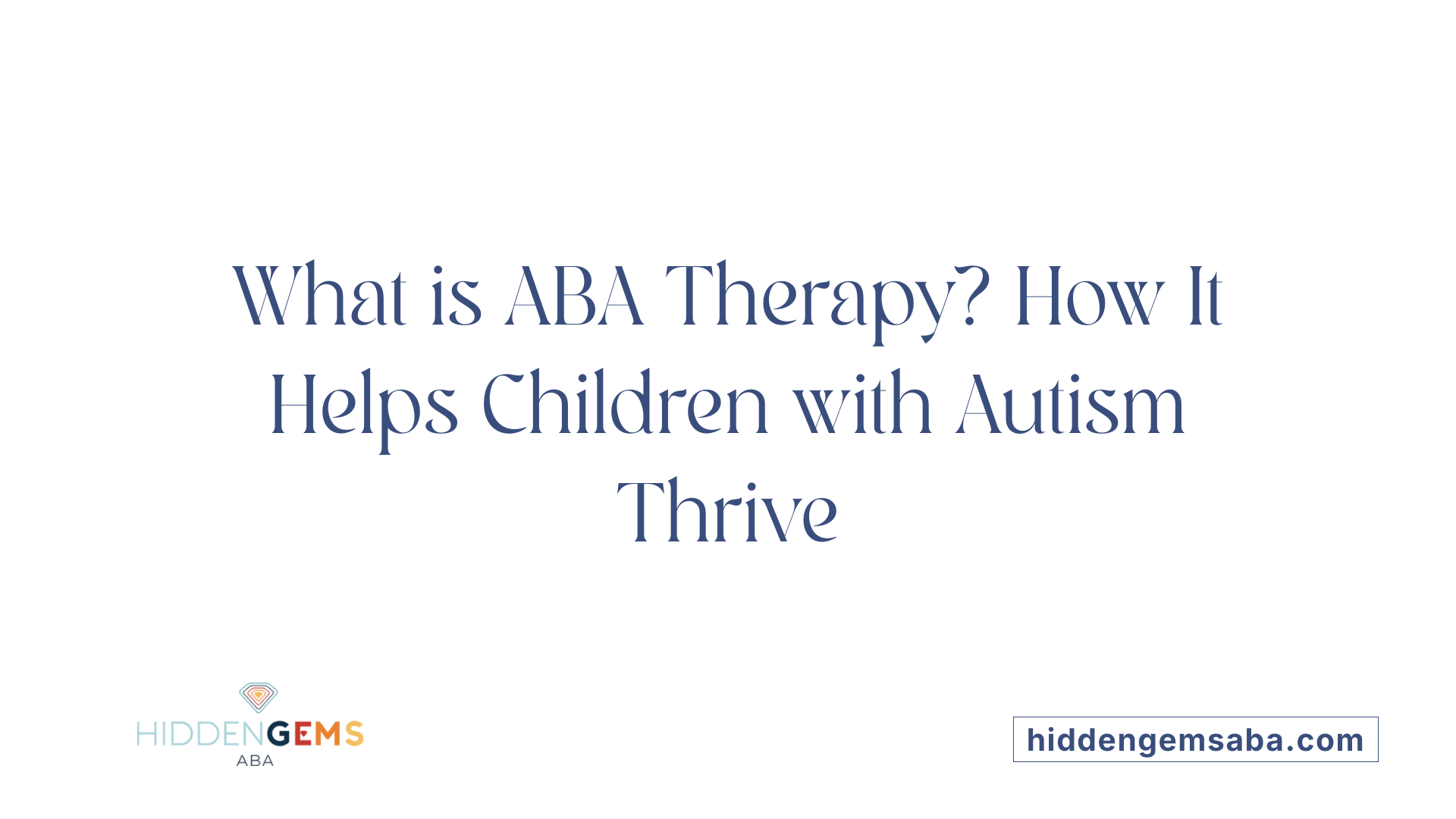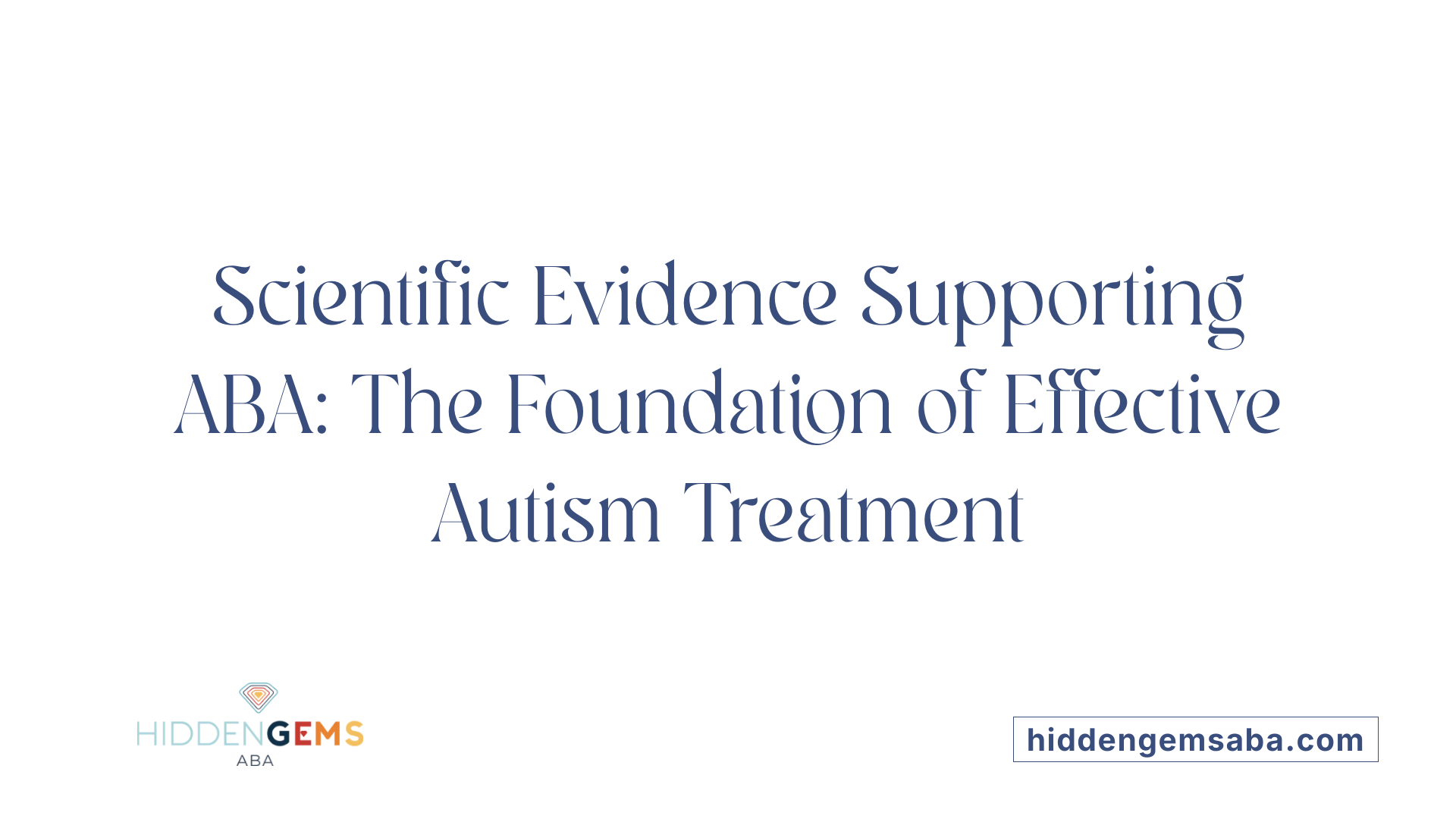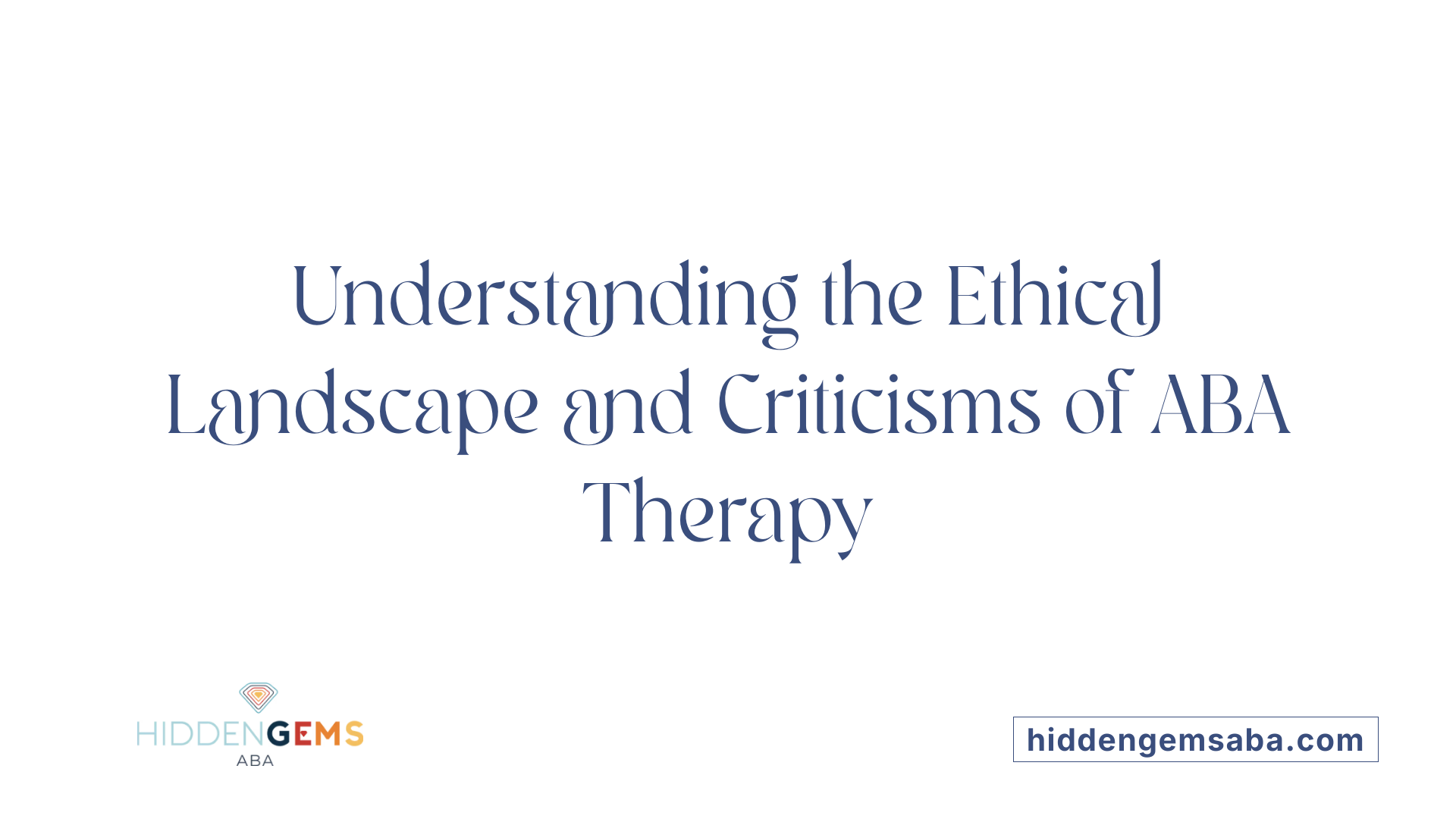Understanding ABA Therapy and Its Role in Autism Care
Applied Behavior Analysis (ABA) is a scientifically supported therapeutic approach that utilizes principles of learning and behavior modification to support individuals with autism spectrum disorder (ASD). Its evidence-based methods are designed to foster essential skills, reduce harmful behaviors, and promote independence, making it one of the most widely accepted interventions in autism health today.
What Is ABA Therapy and How Does It Work for Autism?

What is ABA therapy and how does it work for autism?
ABA, or Applied Behavior Analysis, is a scientifically validated approach rooted in the science of learning and behavior. It is designed to help individuals with autism spectrum disorder (ASD) acquire important skills and reduce behaviors that may hinder their development.
This therapy is highly personalized, with programs tailored to the unique needs, strengths, and interests of each individual. A team of professionals, typically including Board Certified Behavior Analysts (BCBAs) and registered behavior technicians (RBTs), work together to develop and oversee these programs. They conduct initial assessments to understand the child's current skills and challenges, then craft a plan focused on achievable goals across various developmental areas.
ABA employs a variety of techniques to promote learning. Common methods include Positive Reinforcement, where desired behaviors are rewarded to increase their likelihood of recurrence. For example, praise, tokens, or preferred activities may be used as rewards. Structured strategies like Discrete Trial Training (DTT) involve breaking skills into small, manageable steps, providing clear instructions, and reinforcing correct responses. Naturalistic approaches such as Pivotal Response Treatment (PRT) focus on engaging children during play and daily routines, making learning more natural and enjoyable.
One fundamental concept in ABA is understanding the 'A-B-Cs' — Antecedents, Behavior, and Consequences. Antecedents are what happen before a behavior occurs, such as a question or a prompt. The behavior is the action the child displays, like speaking or following instructions. Consequences are what happen after the behavior, such as a reward or a response that might reinforce or discourage the action. By analyzing these factors, therapists can implement strategies to increase desirable behaviors and decrease problematic ones.
Research consistently supports the effectiveness of ABA, especially when delivered intensively over a sustained period—typically more than 20 hours per week during early childhood. It has been shown to improve language, social skills, attention, memory, and daily living abilities, resulting in greater independence. Many insurance plans, including Medicaid and private insurers, recognize ABA as a covered benefit when medically necessary.
Overall, ABA is adaptable and flexible, possible to implement across various settings like home, school, or community environments. Its scientifically grounded methods provide a pathway for children with autism to learn, grow, and participate more fully in society.
The Proven Benefits and Effectiveness of ABA in Autism Support

What are the benefits and effectiveness of ABA therapy for individuals with autism?
Applied Behavior Analysis (ABA) is a well-established, scientifically supported treatment specifically designed for children and youth with autism spectrum disorder (ASD). This therapy focuses on understanding the environmental factors that influence behavior, utilizing strategies like positive reinforcement to encourage helpful actions and reduce harmful or disruptive behaviors.
One of the primary benefits of ABA is its ability to enhance critical skills. Through carefully designed and individualized programs, ABA can significantly improve language and communication abilities, which are often challenging for children with autism. It also promotes better social skills, attention span, and memory, enabling children to engage more effectively with their surroundings.
In addition to skill development, ABA aims to decrease problem behaviors that interfere with learning and daily life. Techniques such as discrete trial training (DTT), natural environment teaching (NET), and pivotal response treatment (PRT) are commonly used to teach new skills and promote generalization across settings.
Research consistently shows promising outcomes. Most studies report that between 63% and 88% of participants experience improvement in areas like cognitive functioning, adaptive behavior, social interaction, and reduction of autism symptoms. For example, a comprehensive review of 770 studies found that improvements were observed across seven of eight key outcome measures, demonstrating ABA's broad impact.
The effectiveness of ABA depends on several factors:
- Intensity and Duration: Programs exceeding 20 hours a week, particularly during early childhood, tend to produce the most substantial benefits.
- Personalization: Tailoring interventions to meet the unique needs, strengths, and interests of each individual enhances learning efficiency.
- Early Intervention: Starting therapy at a young age significantly improves developmental gains.
Most individuals receiving high-quality, evidence-based ABA therapy show meaningful progress that supports greater independence and social participation. Although access to consistent treatment can be challenging due to insurance coverage and availability of trained professionals, the evidence firmly supports ABA as a cornerstone intervention in autism support plans.
Continued research emphasizes the importance of large-scale studies that compare ABA with other interventions and measure quality of life (QoL). These studies aim to refine approaches further and ensure that treatments not only improve functional skills but also enhance overall well-being.
In summary, ABA's proven track record, supported by over 20 studies, highlights its effectiveness in helping individuals with autism develop essential skills and reduce problematic behaviors. Its adaptable nature allows it to be incorporated into various settings, including home, school, and community, making it a versatile and valuable tool in autism intervention strategies.
The Scientific Foundation and Evidence Supporting ABA Therapy

What scientific evidence supports the use of ABA therapy for autism?
Applied Behavior Analysis (ABA) is firmly rooted in scientific research. Over the years, numerous studies and meta-analyses have examined its effectiveness in supporting children with autism spectrum disorder (ASD). These investigations consistently show that ABA can lead to meaningful improvements in a variety of developmental areas.
Meta-analyses, which compile findings from multiple studies, reveal that early and intensive ABA interventions—typically more than 20 hours per week—are associated with small to moderate gains. These benefits include enhancements in adaptive behaviors such as daily living skills, communication, social interactions, and cognitive development. The effect sizes from these studies suggest that the improvements are not only statistically significant but also practically meaningful.
Research findings demonstrate that most children receiving ABA therapy experience positive changes. For example, many studies report reductions in problematic or challenging behaviors, which can improve the child's ability to participate socially and engage in learning. Additionally, children often show progress in language development and social skills, which are crucial for greater independence.
The body of evidence emphasizes the importance of individualized treatment plans. Modern ABA practices are person-centered, using positive reinforcement—rewards like praise, tokens, or preferred activities—to encourage desirable behaviors. This approach avoids the use of punishment or aversive methods, aligning with current scientific understanding that positive strategies are most effective and ethical.
Overall, scientific research affirms that ABA is an evidence-based, effective intervention for many children with autism. Its principles are supported by rigorous studies, and its practices are continually refined based on ongoing research. This makes ABA a highly recommended option within the spectrum of autism therapies.
Outcome measures and improvements seen in studies
Studies on ABA document a broad range of positive outcomes. Most research reports improvements in cognitive abilities, communication skills, and social interaction.
A typical review found that between 63% and 88% of studies indicate beneficial effects of ABA. These include increased independence, better behavioral regulation, and skill acquisition across multiple domains.
Furthermore, the systematic tracking of progress using science-based tools allows practitioners to modify programs to maximize benefits. This ongoing assessment ensures that therapy remains personalized and goal-oriented.
While most studies focus on skill development and behavior reduction, some research also suggests that ABA can impact emotional well-being and reduce autism symptoms—all contributing to overall quality of life.
However, it is notable that few studies have directly measured quality of life outcomes, implying a need for future research to include this important aspect.
Historical context and current scientific consensus
Historically, ABA emerged in the 1960s as a rigorous, data-driven approach based on the science of learning and behavior. Early methods involved structured, repetitive tasks and, regrettably, included some use of punishment techniques.
Today, the field has evolved significantly. Modern ABA emphasizes naturalistic, engaging, and individualized approaches. Techniques such as Discrete Trial Training (DTT), Pivotal Response Treatment (PRT), and the Early Start Denver Model (ESDM) are now standard. These methods focus on making learning fun and relevant, reducing reliance on repetitive drills.
The current scientific consensus recognizes ABA as a gold-standard, evidence-based treatment for autism, with broad support from organizations such as the CDC and the American Psychological Association. Multiple scientific reviews have confirmed its effectiveness, especially when applied early and intensively.
Moreover, the field continues to advance, aiming to incorporate quality-of-life measures and comparative studies with other interventions. As research progresses, ABA remains a cornerstone of autism support, built on a solid foundation of empirical evidence and continuous improvement.
Core Techniques and Strategies Used in ABA Therapy

What methods and techniques are used in ABA therapy for autism?
ABA therapy employs a wide range of proven methods and techniques to help individuals with autism develop new skills and reduce challenging behaviors. These approaches are rooted in scientific principles and are tailored to meet each person's unique needs.
One of the fundamental strategies is positive reinforcement. This involves rewarding desirable behaviors with praise, tokens, or preferred activities, encouraging the individual to repeat these behaviors. Reinforcement can be used across different settings, from home to school, making learning enjoyable and effective.
Prompts are another essential element. They serve as cues or hints to help initiate a behavior. As the individual becomes more confident, these prompts are gradually faded to support independence. Techniques like modeling and video modeling are used to demonstrate the correct way to perform a behavior, which the individual can then imitate.
Behavior chaining links together small steps or behaviors into a complete sequence, aiding in learning complex tasks like dressing or bathing. Discrete Trial Training (DTT) is a highly structured approach where each skill is broken into simple, repeatable trials, providing clear instructions and immediate reinforcement.
Natural Environment Teaching (NET) or natural environment methods emphasize learning in everyday settings. This approach promotes skill generalization by embedding teaching moments into play and daily routines.
The ABC framework—Antecedents, Behaviors, and Consequences—helps analyze behavior. By understanding what triggers a behavior and what follows it, therapists can modify the environment to encourage positive behaviors and reduce negative ones.
Other techniques include the use of fading and shaping to gradually modify behaviors, video modeling to demonstrate social skills, and chaining to build complex behaviors from smaller units—all aimed at fostering independence and functional skills.
Overall, ABA therapy's versatility and evidence-based nature make it a powerful tool for supporting individuals with autism in achieving meaningful progress.
How do the ABA techniques integrate into practical sessions?
In practice, ABA sessions are highly individualized, combining these methods to suit the child's learning style and goals. For example, a session might involve structured DTT exercises followed by play-based NET interventions, with ongoing use of reinforcement and prompting techniques. These strategies work together to create a stimulating yet supportive environment that promotes skill development and behavioral improvements.
Navigating Access, Eligibility, and Starting ABA Therapy

How can a child access and start ABA therapy, and what are the eligibility criteria?
Getting started with ABA therapy involves several crucial steps. First, a diagnosis of autism spectrum disorder (ASD) or another developmental disorder must be made by a qualified healthcare professional, such as a pediatrician, psychologist, or developmental specialist. This diagnosis serves as the foundation for seeking treatment and eligibility.
After diagnosis, families should verify insurance coverage, as many private insurance plans, Medicaid, and employer-sponsored plans recognize ABA as a medically necessary service. Insurance coverage can significantly reduce out-of-pocket costs and streamline access.
The next step is to contact licensed ABA providers or regional centers that offer these services. An initial evaluation is generally required to assess the child's specific needs, strengths, and areas for growth. These evaluations are conducted by a team that often includes a Board-Certified Behavior Analyst (BCBA) who will develop a personalized treatment plan based on the child's unique profile.
Eligibility for ABA therapy typically requires a formal diagnosis of autism or a related developmental condition. Additional criteria may include age and the child's ability to participate in therapy sessions. Public programs, such as those under the Individuals with Disabilities Education Act (IDEA), regional centers, or insurance authorizations, can help facilitate access. Regions vary in their processes, but common requirements involve a referral from a healthcare professional and prior approval from insurance or regional agencies.
Once the necessary paperwork, evaluations, and authorizations are completed, families can schedule therapy sessions, which may occur in various environments such as home, school, or clinical settings. The treatment plan is often tailored and adaptable, focusing on functional goals that improve everyday skills.
In summary, starting ABA therapy involves diagnosing the child, confirming insurance coverage, undergoing initial assessments, obtaining necessary approvals, and then beginning personalized sessions. This organized process helps ensure that each child receives tailored support that addresses their specific developmental goals.
| Step | Description | Participants | Additional Notes |
|---|---|---|---|
| Diagnosis | Confirming autism or developmental delay | Healthcare professionals (pediatricians, psychologists) | Required for eligibility |
| Insurance verification | Ensuring coverage for ABA | Family, insurance provider | Many plans include ABA as a covered service |
| Contacting providers | Arranging initial evaluation | Regional centers, ABA clinics | Ensures access to specialized professionals |
| Evaluation & treatment planning | Assessing needs and developing goals | BCBA, team members | Leads to personalized therapy programs |
| Authorization & funding | Securing financial support | Insurance, regional centers | Key step for therapy commencement |
| Therapy initiation | Beginning sessions | Family, therapists | Settings may include home, school, or clinic |
By following these steps, families can navigate the process of securing high-quality ABA services tailored to their child's needs, fostering skill development and improved functioning.
Varieties of Approaches and Care Options within ABA

What are the different approaches and care options within ABA therapy for autism?
Applied Behavior Analysis (ABA) offers a wide range of approaches, all designed to meet the unique needs of each individual with autism. The versatility of ABA is one of its strengths, allowing practitioners to tailor programs that best support the child's development.
One of the foundational methods is Discrete Trial Training (DTT). This structured technique involves breaking down skills into small, manageable steps. Each step is taught through repetitive trials, with positive reinforcement provided for correct responses. DTT is particularly effective for developing language, communication, and daily living skills.
Natural Environment Teaching (NET) is another popular approach that emphasizes learning in natural, everyday settings. This method promotes the generalization of skills by integrating teaching into play and routine activities. It encourages spontaneous use of language and social skills, making learning more engaging and relatable.
Verbal Behavior Therapy (VBT) focuses on improving communication by teaching children how to use words and phrases appropriately. It draws from theories like B.F. Skinner’s analysis of language, aiming to foster functional communication that enhances social interactions.
In addition to these core methods, various techniques are commonly employed across ABA programs. Positive reinforcement remains a central strategy—rewarding desirable behaviors with praise, tokens, or preferred activities to encourage their recurrence. Prompts, such as verbal cues or physical assistance, help guide the child towards correct responses, with fading techniques used later to promote independence.
Modeling is another useful tool, where the therapist demonstrates desired behaviors for the child to imitate. Behavior chaining involves linking several simple behaviors together to complete more complex tasks.
Visual supports, like picture schedules and visual modeling, enhance understanding and aid in skill generalization. These tools help children anticipate what will happen next and clarify expectations.
Behavior management strategies such as extinction (removing reinforcement for unwanted behaviors), redirection, and behavior contracts may be used to reduce challenging behaviors. These interventions are carefully implemented to ensure they are ethical and effective.
Overall, ABA’s flexible framework integrates multiple techniques—from structured teaching to naturalistic and play-based approaches. This broad spectrum allows therapists to design comprehensive programs that target communication, social skills, independence, and adaptive behaviors.
The choice of specific methods depends on the child’s individual profile, including their strengths, needs, and interests. This personalized approach ensures that interventions are both effective and enjoyable, fostering better learning outcomes and improved quality of life for children with autism.
Addressing Criticisms and Ethical Considerations in ABA

What are the criticisms and controversies surrounding ABA therapy in autism treatment?
Applied Behavior Analysis (ABA) has long been recognized as an effective, evidence-based approach for improving skills and reducing harmful behaviors in children with autism. However, it has also faced significant criticisms and ethical debates, especially centered around its historical practices and how it aligns with evolving understandings of neurodiversity.
Historically, early ABA methods sometimes employed aversive techniques, such as electric shocks, punishments, or deprivation strategies, to suppress undesirable behaviors. Although these practices have been widely abandoned in favor of positive reinforcement, their legacy continues to fuel concerns among critics and autistic self-advocates. They argue that such methods could cause psychological trauma, shame, or emotional distress, particularly if implemented harshly or without sensitive, individualized approaches.
One common point of contention is ABA's focus on promoting conformity to neurotypical standards. Critics claim this can lead to a form of masking — where autistic individuals learn to hide stimming behaviors or other natural expressions — which may cause discomfort or identity issues. Many autistic self-advocates feel that ABA, if applied without a person-centered perspective, risks undermining the individual's autonomy and authenticity.
Further ethical concerns relate to the rigidity of some programs. While modern ABA emphasizes positive reinforcement, the structured nature of traditional methods can sometimes feel overly controlling or mechanistic. Critics argue that such approaches may prioritize compliance over comfort or choice, and that they can overlook the child's emotional and sensory needs.
Despite improvements, ongoing debates question whether ABA genuinely respects the neurodiversity perspective. Some argue that the therapy's ultimate goal should not be to normalize behaviors but to support independence and well-being in ways that honor each child's unique perspective. This has led to calls within the community for more flexible, ethical practices that involve the autistic individual and their family in shaping therapy goals.
In summary, while ABA continues to be a valuable tool supported by scientific evidence, the controversy persists around balancing effective skill-building with respect for individual identity, autonomy, and emotional health. The focus is increasingly shifting toward personalized, compassionate approaches that align with ethical standards and the diverse needs of autistic individuals.
Harmonizing Science and Respect in Autism Support
Despite ongoing debates, ABA remains a cornerstone of evidence-based autism intervention, with modern practitioners emphasizing personalized, ethical, and non-aversive strategies. As research expands and understanding of neurodiversity deepens, the future of ABA aims to balance skill development with respect for individual differences, ensuring that therapy not only supports development but also honors the dignity, preferences, and autonomy of autistic individuals.
References
- Applied Behavior Analysis (ABA)
- Applied Behavior Analysis (ABA)
- The Controversy Around ABA
- Applied Behavior Analysis in Children and Youth with ...
- ABA Therapy
- Treatment and Intervention for Autism Spectrum Disorder
- Applied Behavior Analysis (ABA) for Children With Autism
- Common ABA Therapy Strategies for Children With Autism






